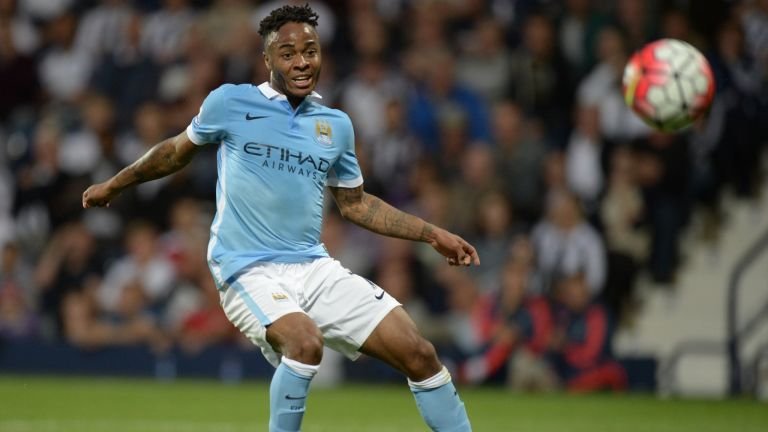It's a new season. The smell of freshly cut grass* permeates the air, the sight of a million predicted tables fills our vision and in our bones we can almost feel the approach of the slightly performative and tired rants about Wenger that many of us will still gleefully RT after Leicester roll Arsenal 3-1 to open the year. But before all that, still one more preview. *though none of that too intricate, soft, weak-chested stuff Here at StatsBomb we've had a fantastic couple weeks previewing the Premier League. Big picture overviews of Swansea, West Ham, Spurs, Everton, Leicester, Arsenal, Manchester City, Manchester United, Liverpool and Chelsea have all come out from a wide array of writers. Now it's time for me to make my triumphant return to StatsBomb like Homer coming back to work from a successful barbershop quartet world tour. 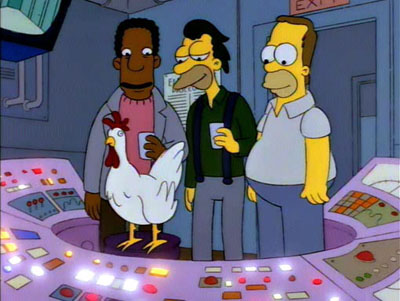
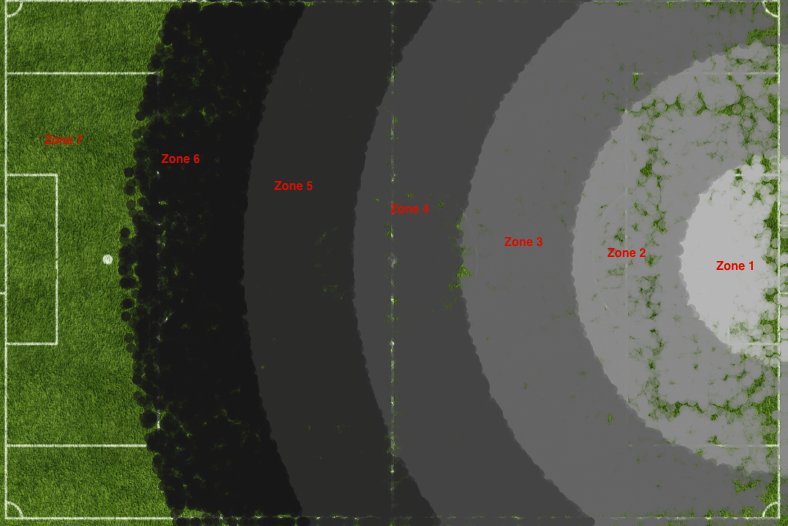 Keep this chart of the different zones handy, I will use it in each different question. Attacking left to right so zone 1 on the right is closest to goal, zone 7 is furthest on the left. 1. Can West Ham get the ball out of midfield?
Keep this chart of the different zones handy, I will use it in each different question. Attacking left to right so zone 1 on the right is closest to goal, zone 7 is furthest on the left. 1. Can West Ham get the ball out of midfield? 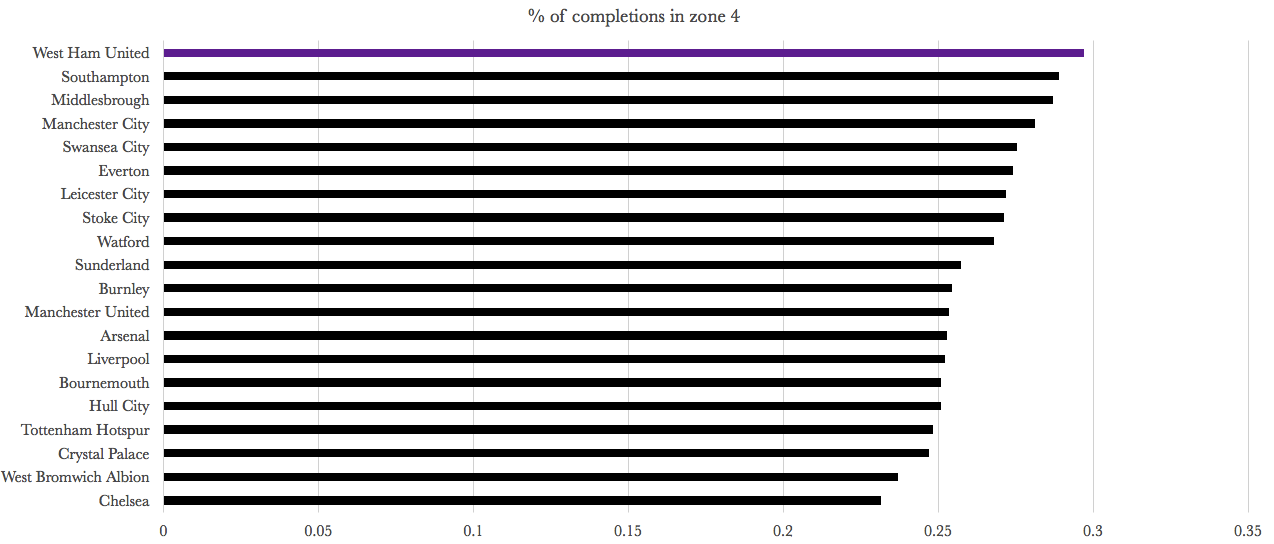
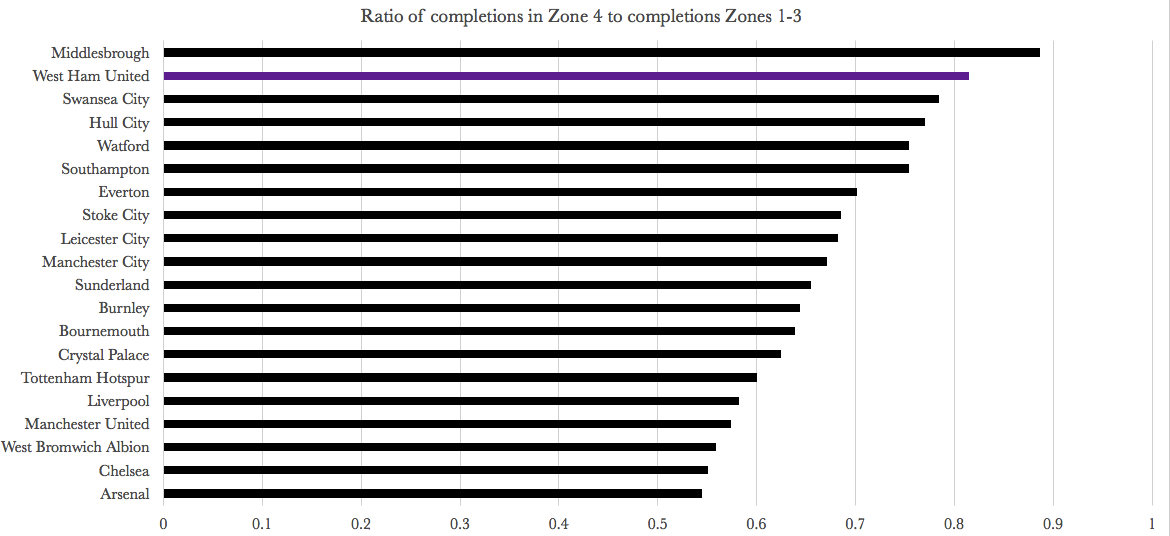 I'm forever playing passes Pretty passes in zone 4. They fly so high, Nearly reach the sky, Then like my dreams, They fade and die. No team in the league had a higher % of their completions coming in the “midfield” zone (4) about 45-60 yards from goal than West Ham. This isn’t a death knell for your attack (see Man City and Everton) but looking at the ratio of completions zone 4 to zones 1-3 (closer to goal) shows the stagnant attacks of Swansea, Hull, and Middlesborough alongside the Hammers. West Ham’s biggest problem is not that they do not complete the forward passes they attempt (mid-pack there), it’s that they simply do not attempt many forward passes from the midfield (31.3% of total passes from the zone go forward, second-fewest in the league). When we drill down to the individual players we find two high-volume passers who simply do not play the ball forward: Manuel Lanzini and Cheikhou Kouyate. They played the 2nd and 3rd most passes on the team from this zone and only passed it forward 24.3 and 22.1% of the time respectively. Among the other 19 teams in the PL, there is only one player who cracks their respective teams top 3 in volume coupled with a sub-25% forward rate: oddly enough it's Burnley's Jeff Hendrick. One Hammer passes back from the right, and one from the left, but both do it often.
I'm forever playing passes Pretty passes in zone 4. They fly so high, Nearly reach the sky, Then like my dreams, They fade and die. No team in the league had a higher % of their completions coming in the “midfield” zone (4) about 45-60 yards from goal than West Ham. This isn’t a death knell for your attack (see Man City and Everton) but looking at the ratio of completions zone 4 to zones 1-3 (closer to goal) shows the stagnant attacks of Swansea, Hull, and Middlesborough alongside the Hammers. West Ham’s biggest problem is not that they do not complete the forward passes they attempt (mid-pack there), it’s that they simply do not attempt many forward passes from the midfield (31.3% of total passes from the zone go forward, second-fewest in the league). When we drill down to the individual players we find two high-volume passers who simply do not play the ball forward: Manuel Lanzini and Cheikhou Kouyate. They played the 2nd and 3rd most passes on the team from this zone and only passed it forward 24.3 and 22.1% of the time respectively. Among the other 19 teams in the PL, there is only one player who cracks their respective teams top 3 in volume coupled with a sub-25% forward rate: oddly enough it's Burnley's Jeff Hendrick. One Hammer passes back from the right, and one from the left, but both do it often. 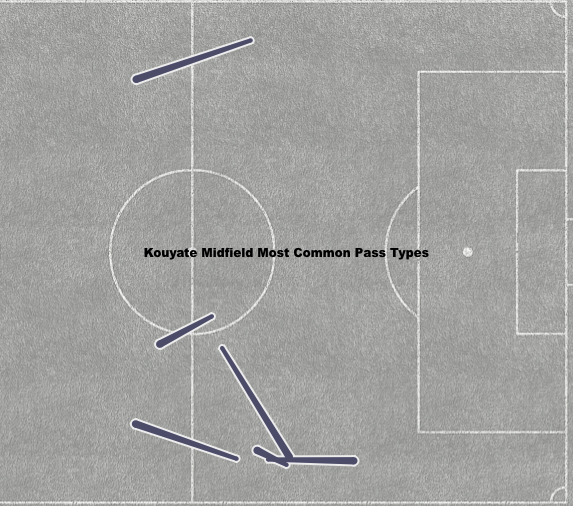
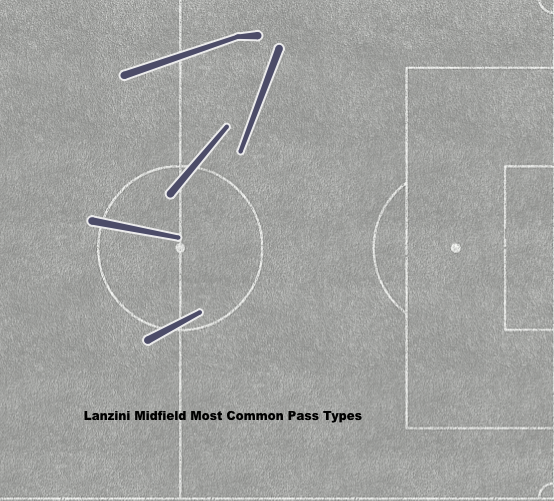 Pass types mean I grouped all PL passes into 100 different types (the start of this article gives a hopefully better introduction). Lanzini is a fascinating case. While he rarely passes forward, when he does so he almost never misplaces a pass. Sort of McClellan-esque if we are going to compare West Ham midfielders to Civil War Union Generals. He's great when he's actually doing his job, but he's a little too hesitant to do it. Only John Stones (good ball-playing center back for Man City, so no surprise) and Mousa Dembélé (widely accepted midfield mega-star) actually complete passes at a higher rate going forward from zone 4. I mean, look at this list:
Pass types mean I grouped all PL passes into 100 different types (the start of this article gives a hopefully better introduction). Lanzini is a fascinating case. While he rarely passes forward, when he does so he almost never misplaces a pass. Sort of McClellan-esque if we are going to compare West Ham midfielders to Civil War Union Generals. He's great when he's actually doing his job, but he's a little too hesitant to do it. Only John Stones (good ball-playing center back for Man City, so no surprise) and Mousa Dembélé (widely accepted midfield mega-star) actually complete passes at a higher rate going forward from zone 4. I mean, look at this list: 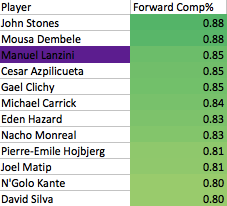 Very odd to see him there amongst the big boys when his team is having such problems moving the ball forward. I suspect Lanzini, while probably lacking options forward, is not being aggressive enough when the ball is played to him. West Ham analysts should be raising their eyebrows at this and trying to get answers from Lanzini and the coaching staff as to why he so often settles for playing the ball sideways or backwards instead of progressing the attack, which he's been one of the best in the league at. Encourage him to do it more, say a few more incompletions might not necessarily be a bad thing as we try to move out this midfield bog. Kouyate is a tougher problem as he showed neither the proclivity to pass forwards or much skill at doing so (league average comp% coming from a deep, deep-lying midfielder is poor). He just doesn't look like a good progressive passer of the ball and being aware of that and developing other ways of moving the ball forward needs to be a focus. Maybe Arnautovic can be a better receiver than say Antonio was, but this will remain an area to watch for West Ham fans in the early weeks of the season. 2. Can the league get the ball in front of Chelsea's goal? Chelsea allowed opponents to have the ball more than any of the other big 6, but were pretty Atletico-ish defending their goal (previous StatsBomb work on Atletico here). Chelsea forced opponents to make more passes per shot than any team in the league, and unsurprisingly that goes hand in hand with allowing little and low quality danger zone access.
Very odd to see him there amongst the big boys when his team is having such problems moving the ball forward. I suspect Lanzini, while probably lacking options forward, is not being aggressive enough when the ball is played to him. West Ham analysts should be raising their eyebrows at this and trying to get answers from Lanzini and the coaching staff as to why he so often settles for playing the ball sideways or backwards instead of progressing the attack, which he's been one of the best in the league at. Encourage him to do it more, say a few more incompletions might not necessarily be a bad thing as we try to move out this midfield bog. Kouyate is a tougher problem as he showed neither the proclivity to pass forwards or much skill at doing so (league average comp% coming from a deep, deep-lying midfielder is poor). He just doesn't look like a good progressive passer of the ball and being aware of that and developing other ways of moving the ball forward needs to be a focus. Maybe Arnautovic can be a better receiver than say Antonio was, but this will remain an area to watch for West Ham fans in the early weeks of the season. 2. Can the league get the ball in front of Chelsea's goal? Chelsea allowed opponents to have the ball more than any of the other big 6, but were pretty Atletico-ish defending their goal (previous StatsBomb work on Atletico here). Chelsea forced opponents to make more passes per shot than any team in the league, and unsurprisingly that goes hand in hand with allowing little and low quality danger zone access. 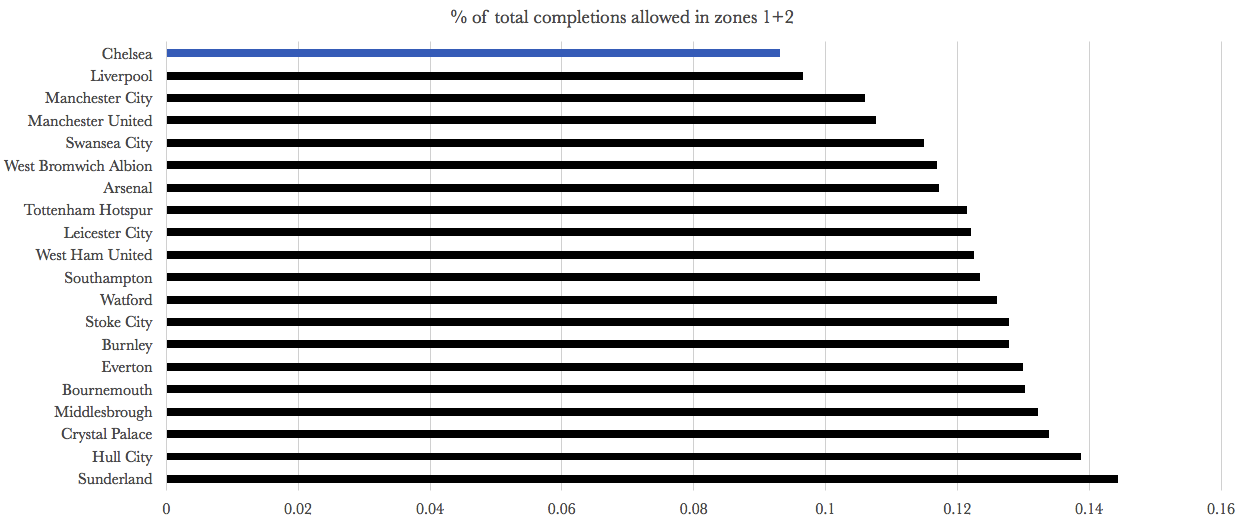
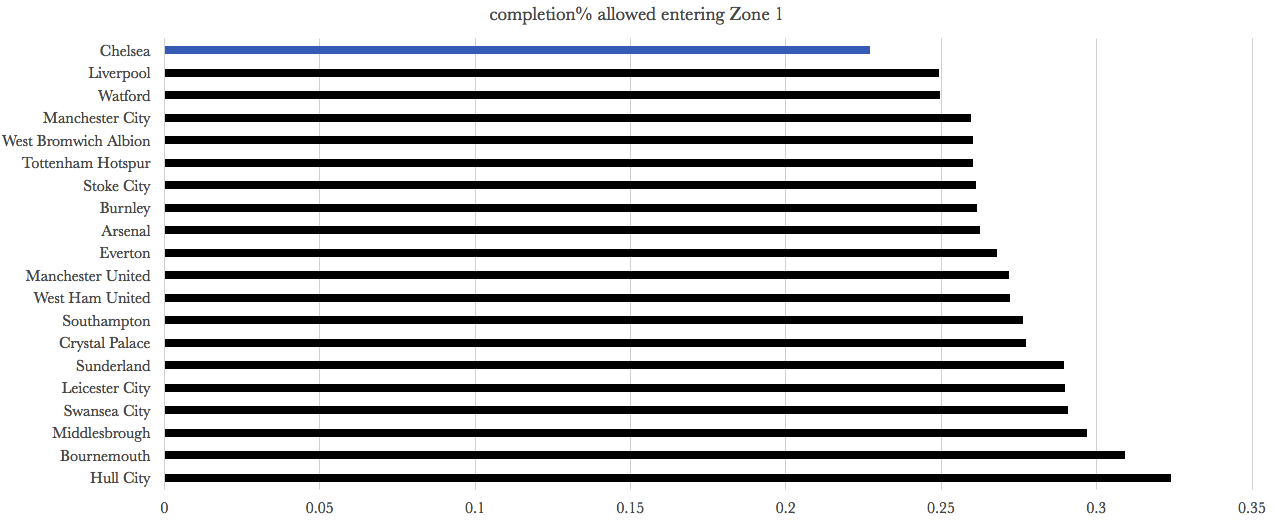 Chelsea do not press high consistently. Teams without renowned presses like Everton, Watford, Crystal Palace, and Arsenal all force opponents into a lower completion % high up the field. Chelsea's defensive set-up is clearly all about protecting that precious area in front of goal, when teams move the ball into the midfield they don't find it easy to go forward. This is the opposite of how many of the other elite defensive teams work (see City/Spurs below), where they harry you into rushing forward and look to win the ball back.
Chelsea do not press high consistently. Teams without renowned presses like Everton, Watford, Crystal Palace, and Arsenal all force opponents into a lower completion % high up the field. Chelsea's defensive set-up is clearly all about protecting that precious area in front of goal, when teams move the ball into the midfield they don't find it easy to go forward. This is the opposite of how many of the other elite defensive teams work (see City/Spurs below), where they harry you into rushing forward and look to win the ball back. 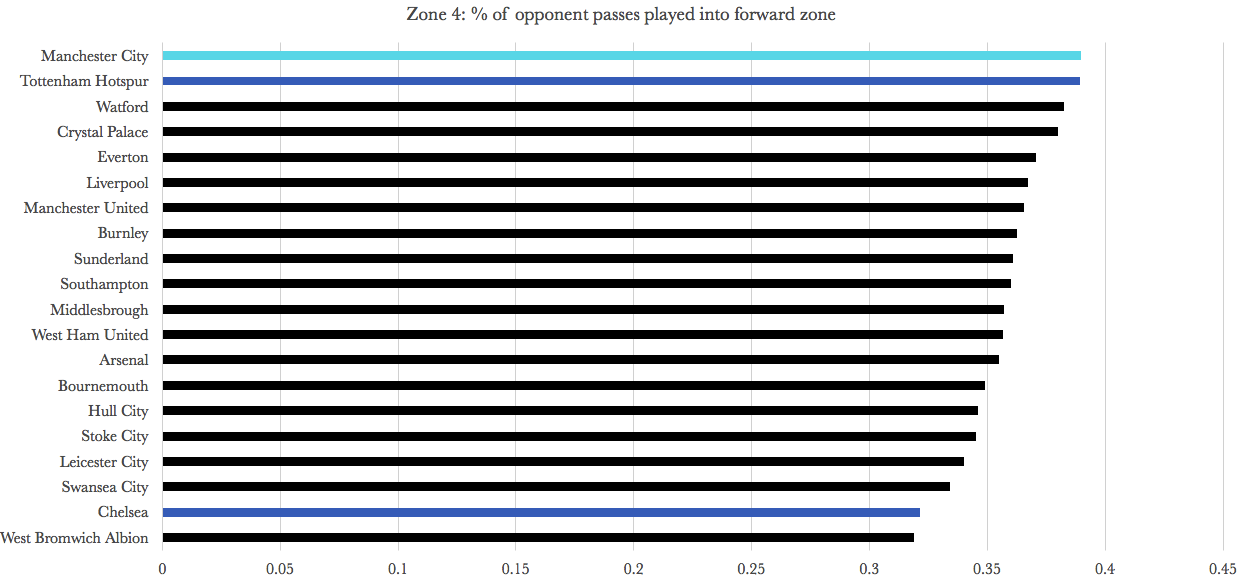 Once you get close to goal Chelsea do not allow you to set up quality shots with short key passes. They allowed 20% fewer sub-10 yard passes in zone 1 (15 yard radius around goal) than the team with the second fewest, Liverpool. Not much high-wire risk about the way Chelsea defend compared to say, Liverpool or Man City. Also, not much much reason to doubt their solidity continuing this year. You can make the case it could be improved with the addition of Bakayoko and Rudiger. However I'm not so sure that stiffening the team without the ball is the easiest way for them to improve shot prevention, right now the risk is probably not having the ball enough. A little less time without the ball might be an easier way of improvement. Aside from that debate, having this sturdy base provides a solid foundation for a title challenge, even if they aren't favorites to repeat. 3. Can Bournemouth's porous defense close up at the back and how good is Eddie Howe?
Once you get close to goal Chelsea do not allow you to set up quality shots with short key passes. They allowed 20% fewer sub-10 yard passes in zone 1 (15 yard radius around goal) than the team with the second fewest, Liverpool. Not much high-wire risk about the way Chelsea defend compared to say, Liverpool or Man City. Also, not much much reason to doubt their solidity continuing this year. You can make the case it could be improved with the addition of Bakayoko and Rudiger. However I'm not so sure that stiffening the team without the ball is the easiest way for them to improve shot prevention, right now the risk is probably not having the ball enough. A little less time without the ball might be an easier way of improvement. Aside from that debate, having this sturdy base provides a solid foundation for a title challenge, even if they aren't favorites to repeat. 3. Can Bournemouth's porous defense close up at the back and how good is Eddie Howe? 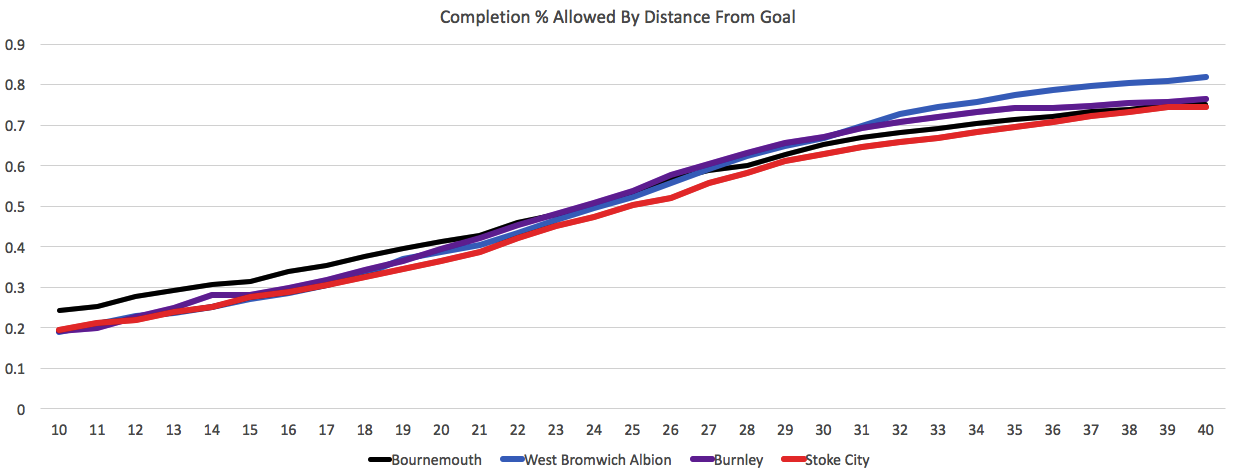 Cherries are not supposed to get softer the closer you get to the core. But look at the stark divergence between Bournemouth and three other lower-half teams as you get inside 20 yards. Two years ago they had a respectably fierce high press but last season that kind of withered away and you are left with this: a team that theoretically tries to press but really just leaves themselves open at the back. That is a recipe that lends itself to giving up 67 goals. That weakness was covered up a bit by a strong finish in the table equal on points with Saints. If Bournemouth want to repeat last year or improve, fixing this should be priority number one. This year will be a big test for Eddie Howe and will help clarify how good a manager he really is right now, there are data points and opinions all over the map on his first few years in the top flight. This year should help us hone in.
Cherries are not supposed to get softer the closer you get to the core. But look at the stark divergence between Bournemouth and three other lower-half teams as you get inside 20 yards. Two years ago they had a respectably fierce high press but last season that kind of withered away and you are left with this: a team that theoretically tries to press but really just leaves themselves open at the back. That is a recipe that lends itself to giving up 67 goals. That weakness was covered up a bit by a strong finish in the table equal on points with Saints. If Bournemouth want to repeat last year or improve, fixing this should be priority number one. This year will be a big test for Eddie Howe and will help clarify how good a manager he really is right now, there are data points and opinions all over the map on his first few years in the top flight. This year should help us hone in. 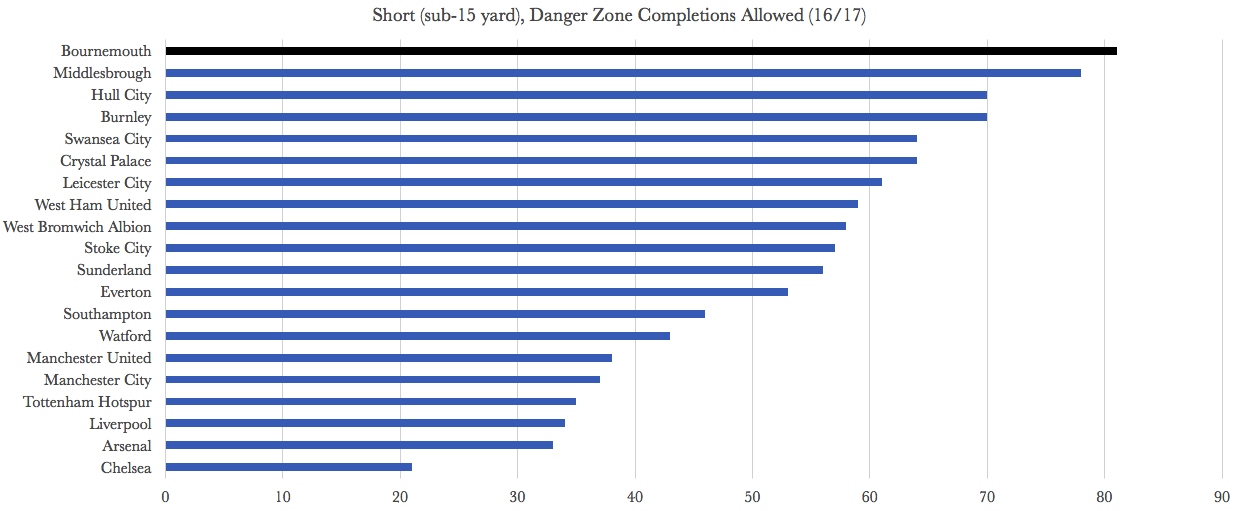 4. Will Burnley develop an alternative to their hit-and-hope build-up play? After Bournemouth, we come to their near-opposite in Sean Dyche's Burnley. Not only for their defensive divergence we saw above but for how they build up.
4. Will Burnley develop an alternative to their hit-and-hope build-up play? After Bournemouth, we come to their near-opposite in Sean Dyche's Burnley. Not only for their defensive divergence we saw above but for how they build up. 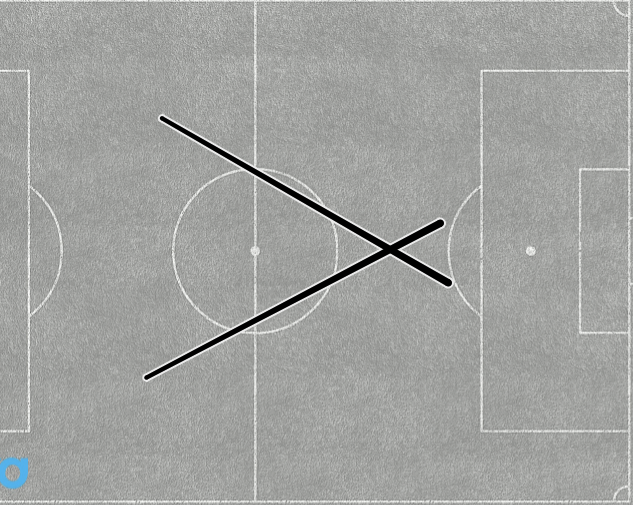
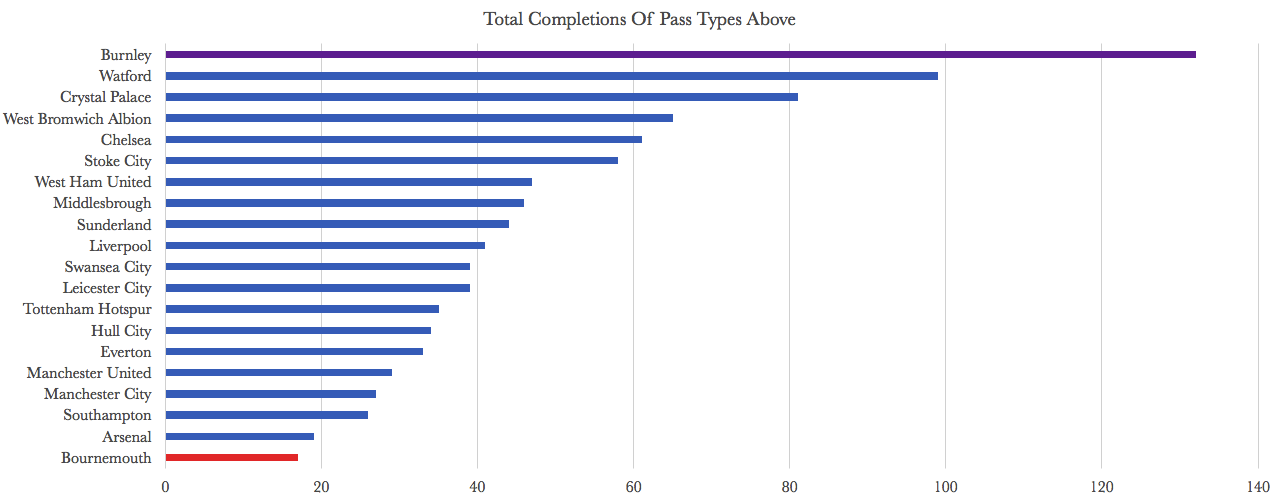
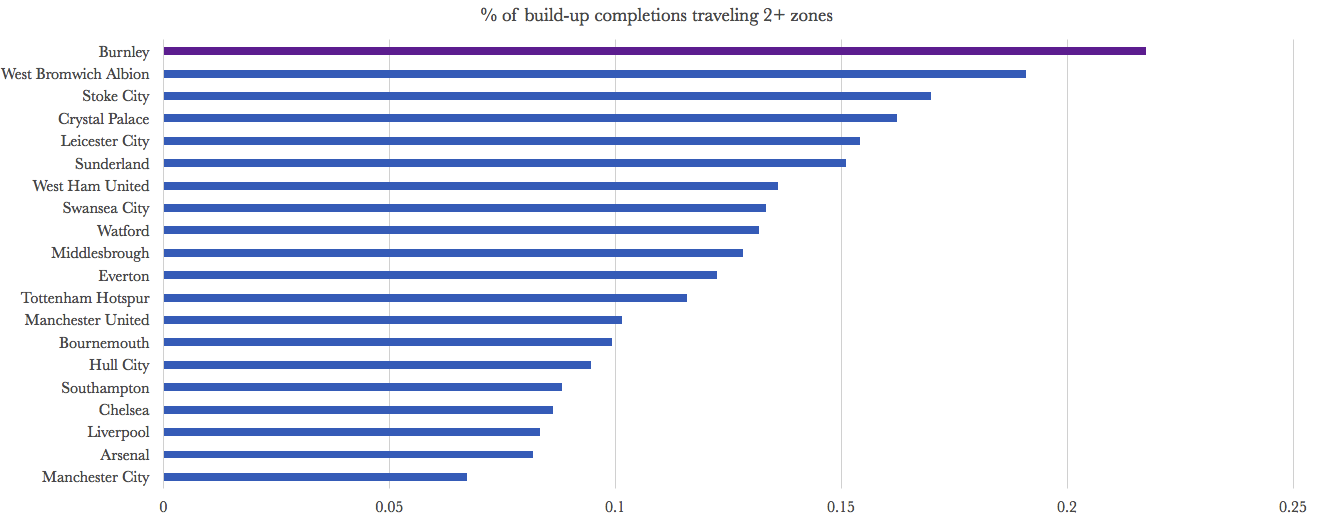 They stayed up deservedly through what was a distinctive long ball and shell in the box playing style but are one of the favorites to go down this season showing bookies are skeptical they can do it again. Burnley's best player %-wise at moving the ball forward from zones 5 and 4? Michael Keane, now an Everton player. New man Jack Cork presumably will be asked to be a progressive passer from midfield as Keane's loss will put more pressure on Burnley's midfielders to actually move the ball. Last year Marney and Hendrick would move the ball forward about as often as Sean Dyche made an appointment to get his hair styled.
They stayed up deservedly through what was a distinctive long ball and shell in the box playing style but are one of the favorites to go down this season showing bookies are skeptical they can do it again. Burnley's best player %-wise at moving the ball forward from zones 5 and 4? Michael Keane, now an Everton player. New man Jack Cork presumably will be asked to be a progressive passer from midfield as Keane's loss will put more pressure on Burnley's midfielders to actually move the ball. Last year Marney and Hendrick would move the ball forward about as often as Sean Dyche made an appointment to get his hair styled. 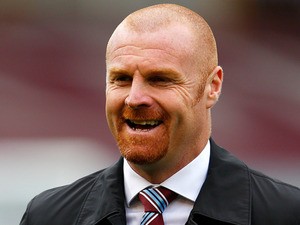 The numbers do not indicate Cork as Burnley's Iniesta. Cork was a quite hesitant player on Swansea and his percentages did not stand out at all relative to teammates (while they do compared to Burnley, the odds of that transferring are quite low).
The numbers do not indicate Cork as Burnley's Iniesta. Cork was a quite hesitant player on Swansea and his percentages did not stand out at all relative to teammates (while they do compared to Burnley, the odds of that transferring are quite low). 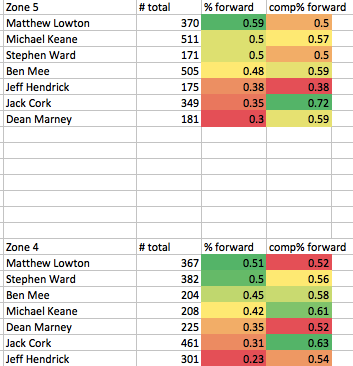 Burnley will likely remain a team that spends little time working through the middle and hopes they can pressure you with their defense and hit a few long balls over you to get shots. I suspect it won't work quite as well the second time through the league. And one more tip for Sean Dyche before we leave: go with the 3 on the sides, 5 up top next time, stop confusing the barbers with your elaborate requests. 5. Can City solve their strange in-box passing problem and become a super-powered attack?
Burnley will likely remain a team that spends little time working through the middle and hopes they can pressure you with their defense and hit a few long balls over you to get shots. I suspect it won't work quite as well the second time through the league. And one more tip for Sean Dyche before we leave: go with the 3 on the sides, 5 up top next time, stop confusing the barbers with your elaborate requests. 5. Can City solve their strange in-box passing problem and become a super-powered attack? 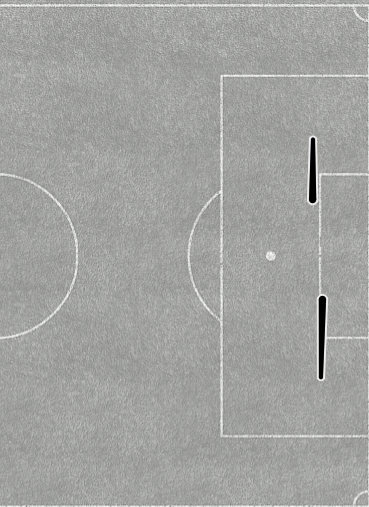
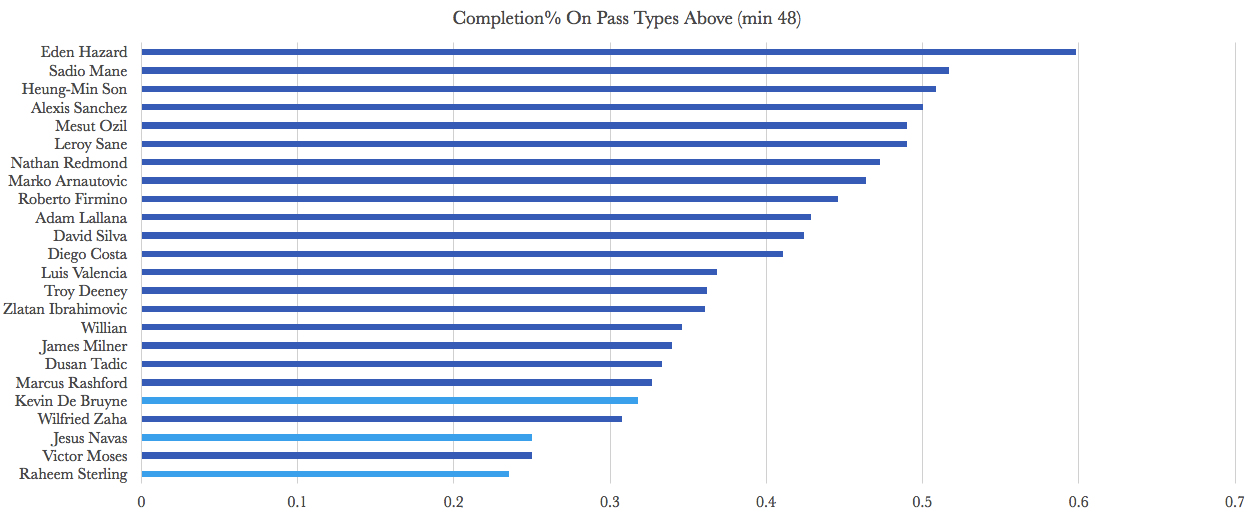 Why is one of the best play-makers in the league down sub-Milner on intra-box passes from the side? Yes, City probably face packed boxes but so does almost everyone on this list. De Bruyne and Sterling played 102 and 85 of these passes each, so it conceivably could be an oddity like the store that's 2 weeks from everywhere. But just going on gut feel after trawling through tons of this type of data, I don't think there are as many wild swings without good reason like there are with shot conversion. Usually there is some explanatory power in smallish samples. What makes this a tough one to explain is Nolito, Silva, Sane and Aguero were all perfectly fine and well above-average playing these types of passes. For Sterling you might be able to write it off as a guy adjusting to a new system. There were other signs of an adjustment period playing under Pep, he posted his lowest completion % of his career with weird outliers like this and also almost leading the league in proportion of backwards or sideways passes from midfield. For Navas it's somewhat easy to rationalize as a guy who gets too nervous inside the box, for De Bruyne it's a genuine puzzler. If anyone can figure it out though, it should be KdB playing under Pep. If City could just get those 3 stragglers up to the rest of team average at completing these passes, that's something like 40 more possessions inside the opponents box and an attack that's even scarier. With that alongside their opponents conversion likely to see some regression from last season and the enormous money spent out wide, City seem to be deserving favorites heading into the season. Watch and see though if their main men continue to struggle playing that final ball. Well, that's about it. The entire StatsBomb gang is now back together writing about the 2017/18 PL season and proclaiming from the rooftops how the season will go. Anyway, hope you enjoyed the piece and enjoy the season...and get the tear gas.
Why is one of the best play-makers in the league down sub-Milner on intra-box passes from the side? Yes, City probably face packed boxes but so does almost everyone on this list. De Bruyne and Sterling played 102 and 85 of these passes each, so it conceivably could be an oddity like the store that's 2 weeks from everywhere. But just going on gut feel after trawling through tons of this type of data, I don't think there are as many wild swings without good reason like there are with shot conversion. Usually there is some explanatory power in smallish samples. What makes this a tough one to explain is Nolito, Silva, Sane and Aguero were all perfectly fine and well above-average playing these types of passes. For Sterling you might be able to write it off as a guy adjusting to a new system. There were other signs of an adjustment period playing under Pep, he posted his lowest completion % of his career with weird outliers like this and also almost leading the league in proportion of backwards or sideways passes from midfield. For Navas it's somewhat easy to rationalize as a guy who gets too nervous inside the box, for De Bruyne it's a genuine puzzler. If anyone can figure it out though, it should be KdB playing under Pep. If City could just get those 3 stragglers up to the rest of team average at completing these passes, that's something like 40 more possessions inside the opponents box and an attack that's even scarier. With that alongside their opponents conversion likely to see some regression from last season and the enormous money spent out wide, City seem to be deserving favorites heading into the season. Watch and see though if their main men continue to struggle playing that final ball. Well, that's about it. The entire StatsBomb gang is now back together writing about the 2017/18 PL season and proclaiming from the rooftops how the season will go. Anyway, hope you enjoyed the piece and enjoy the season...and get the tear gas.
2017
Getting Down To The Nitty-Gritty: 2017/18 Season Preview
By admin
|
August 11, 2017
